|
Getting your Trinity Audio player ready...
|
Other articles in this series:
The Art of Dress – Two Schools of Thought
The Art of Dress – Problems with Normalcy
The Art of Dress – Learning from the Valiant Woman
The Art of Dress – What Nuns can Teach Us
The Art of Dress – A Survey of Principles
Responding to my recent essay, The Art of Dress – A Survey of Art Principles, a reader observed that although I promoted beautiful dress in the abstract, the example clothing I presented as illustrations fell short of beauty; he called it rather “pretty” or “elegant,” statements with which I wholeheartedly agree.
The truth of the matter is that contemporary dress lacks beauty. By contemporary dress, I mean not only shapeless T-shirts, yoga pants, and ripped jeans, but also the very best that today’s society can muster. Certainly, we may still find clothing that we call pretty or elegant, but to call an ensemble beautiful, it must possess some mark of excellence far above our typical Sunday best, and it is this excellence that virtually all modern clothing lacks.[1]
In his Aesthetics, Deitrich von Hildebrand presents the “family” of aesthetic values which includes the lovely, the graceful, the pretty, the charming, and the poetic, among others. The queen of the aesthetic values is beauty.[2] Hildebrand goes on to make an important distinction between beauty and elegance. The latter value he identifies as “this-worldly,” whereas beauty is “other-worldly.” Though he considers elegance certainly within the family of aesthetic values and closely related to gracefulness, he sees it also as rooted in the mundane. Elegance, Hildebrand writes, has no place in eternity. [3] This, then explains the tension one feels at paintings which depict certain modern saints in three-piece suits or physicians’ jackets among the choirs of Heaven. Whereas saints of former centuries have enjoyed raiment that, due to its beauty, transposes easily to portrayals of the Heavenly court, the clothing of modern saints invariably strikes a discordant note; one cannot apotheosize a man wearing trousers and a necktie.
To further explore the different between elegance and beauty, let us consider the images below:

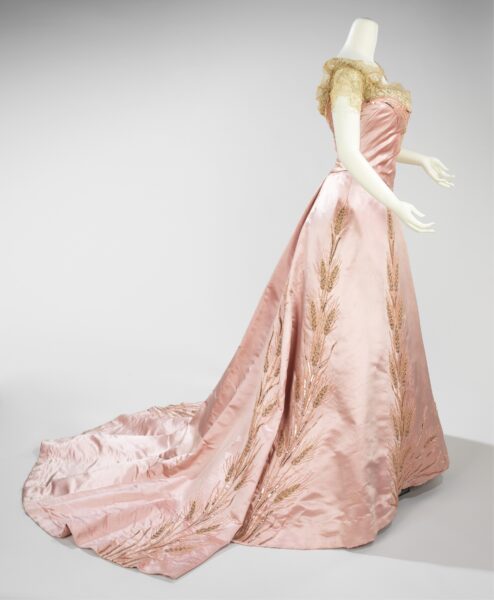
On the left, we see a contemporary evening dress inspired by the New Look of the 1950s. I use this dress often to demonstrate the successful application of the principles of harmony, proportion, balance, rhythm, and emphasis. Its quiet grace, clean modern lines, and indisputable air of refinement make it an apt illustration of elegance.
The dress on the right, designed in 1900, also possesses grace, but now it is a sweeping, radiant grace at once more youthful and more regal than that of the black dress. The long lily-like lines, the abundance of precious fabric, and the exquisite ornamentation of embroidery and gold needle lace all do their part to make the pink gown truly beautiful.
It is interesting to note that within the realm of the elegant itself one finds a spectrum, with some items bearing more grace and drawing nearer that other-worldly quality of beauty than others. Below are two examples that demonstrate the range of the elegant.
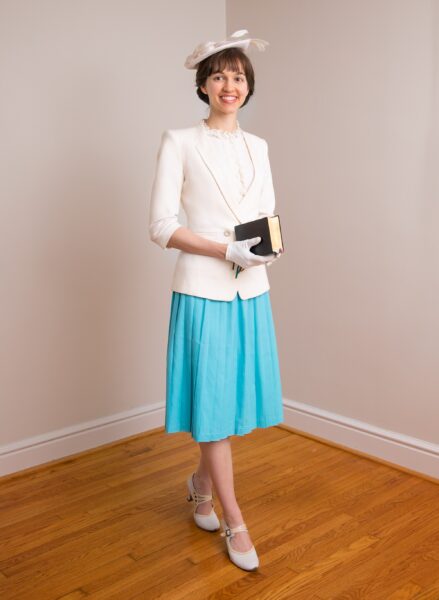
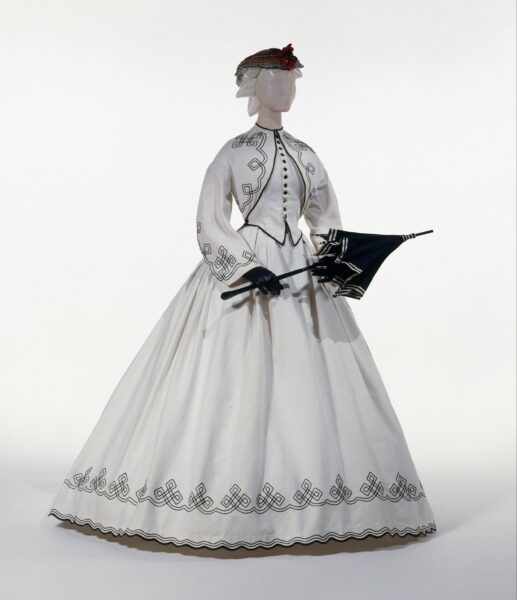
At left, we see a contemporary Easter Sunday suit inspired by the style of the 1940s. A pleated skirt and a jacket worn with chiffon ruffles at the throat, a feathered hat, gloves, and feminine shoes combine to make a relatively elegant lady’s ensemble. But compare this to a promenade dress of the 1860s which perhaps was once also worn on an Easter Sunday. Immediately, one notices that the promenade dress exudes a certain fullness and grace that the modern suit lacks. Contrast the two skirts: The suit’s short skirt forms a stiff rectangle over the legs; the promenade dress’s splendid bell does not cut across the legs but flows gracefully in one continuous curve over them. Next note the suit jacket, all angles and stark lines, the style Christian Dior remarked as worn by “soldier-women with shoulders like boxers.”[4] Compare these sharp lines to those that make up the promenade dress’s Zouave-style jacket. From the wrists to the earlobes the Zouave jacket draws two S-curves along its sleeves like the graceful scrolled arms on either side of a Grecian vase. Note again, the S-curves flowing down from the jacket’s closure at the throat, across the bosom, and along the bell of the skirt. At the hem of the skirt, one finds yet another homage to the S-curve in charming embroidery, playfully echoed and expanded upon throughout the ensemble. And how can one not but marvel at the perfect craftsmanship of the fitted bodice, so trim, and yet, not in the least departing from the beauty of the feminine form?
While the lines of the contemporary suit do have their aesthetic appeal, cutting what one might call a “smart” figure, the promenade dress’s fullness, generated by a graceful symphony of curves, tells more truly of feminine nature and speaks of something higher and more noble than the merely sophisticated woman.
And yet, notwithstanding the undeniable artistic success of the promenade dress, it does, in the end, possess elegance rather than beauty. It, like much of Victorian fashion, bears an ineluctable spirit of modernity that firmly ties it to this world. The Victorians’ romanticism still fostered ideals like the graceful feminine curves aided by voluminous skirts; but the creeping spirits of hurry and egalitarianism, fueled by growing industrialization, left their mark; women found they could have those voluminous skirts without the weight of petticoats or the expense of the hand-crafted wooden panniers of the previous century; they only needed steel cage-crinolines, fruits of some of the world’s first mass-production.[5] They no longer needed linen from the village weaver; those yards of cotton pique came from global trade and great industrial mills.[6] In short, Victorian dress presents a curious juxtaposition of the highest ideals and all that led to their demise.
Shifting the discussion again to the beautiful, I include this excellent example of truly beautiful dress which comes in Goya’s painting, The Parasol.

While the clothes of this lady and her servant conform to the fashions of their day (the 1770s), they also possess a timeless quality.[7] Fruits of art and the prevailing culture and not mere products of industrialization, their clothing transcends the zeitgeist and speaks of something at once high and profound.
Below is another example of a beautiful dress. In it, one finds the tell-tale characteristics of grace, length of line, fullness, and timelessness.
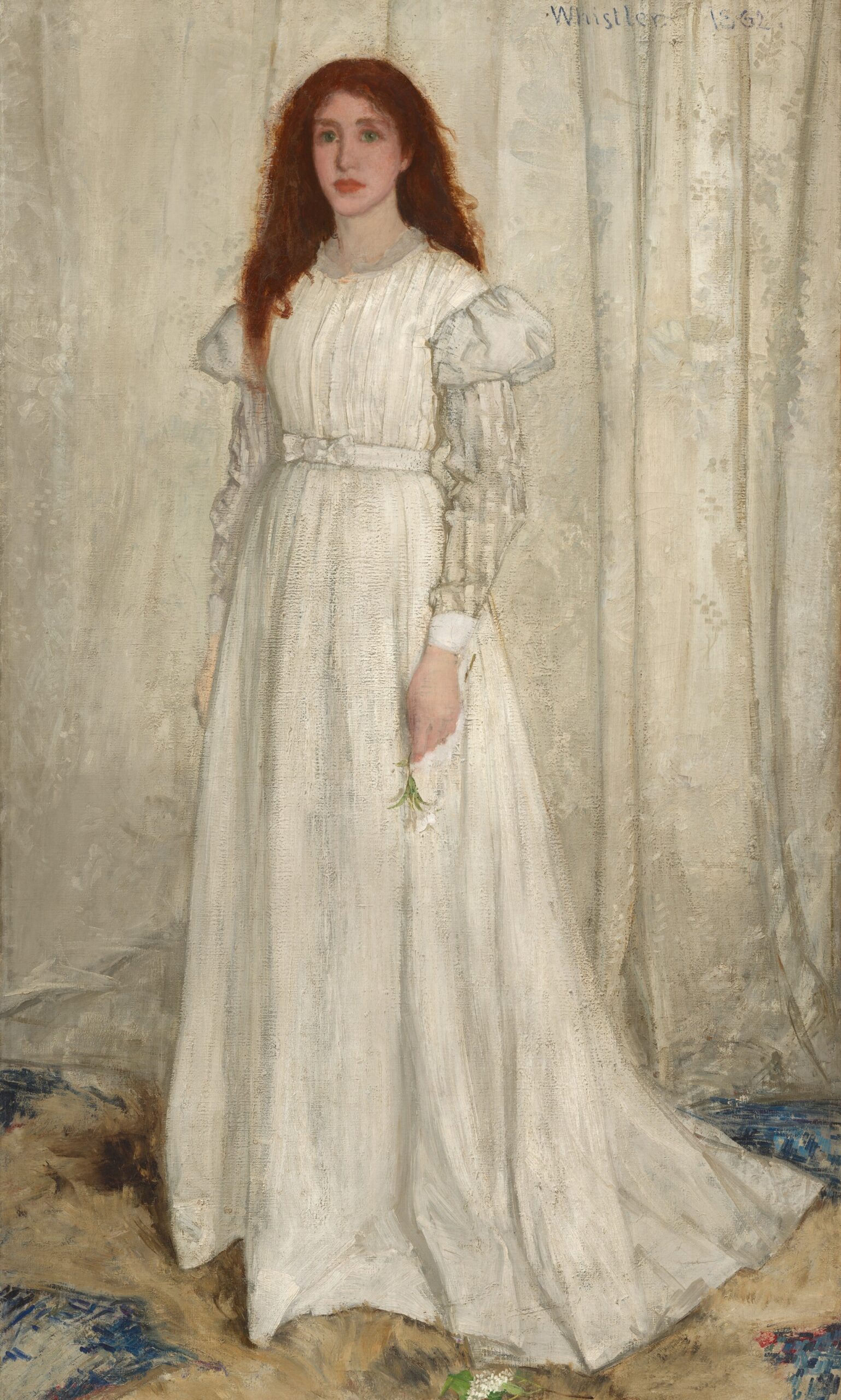
Next consider the Bronzino portrait below versus a subsequent linked photo of the Duchess of Cambridge.

In the portrait, we see a gown of stunning beauty. Its shape, its volume, its color, all contribute to its message of unearthly grandeur while not diminishing its warmth and femininity. There is here, as in my other examples of beauty, a theme of abundance, even superfluity. Why should the lady’s puffed sleeves be so full? Why should she have silk velvet undersleeves? Why lace cuffs beneath those? Why a skirt so voluminous it pushes against the arm of the chair? Why must she have rings, a headband, a belt, and a chain? Is she not the quintessence of what post-moderns love to dismiss as “a bit much”? And yet, in looking at the lady, one finds no frivolity; there is nothing one wishes to strip away from her, nothing that mars or distracts. One wishes rather to rise to her standard! It turns out then, that the “superfluous” features of her raiment are actually the most necessary; they are the very things that make her sublime.
Now contrast the above ensemble, so regal, and yet, so gentle with the gown linked here, worn by the Duchess of Cambridge. Here, stark lines gather to set-off the Duchess’s tight, muscular form, a form ready for the crisp and business-like work of post-modern public relations and the unforgiving lens of the omnipresent camera. This and the gown’s striking lack of all things superfluous, firmly ground it to the earth. While leaving little of the female form to the imagination, the gown obscures the highest truths of femininity. Made for red carpets, motorcades, and flashbulbs, gowns like this may have aesthetic appeal, but that appeal is, at best, merely elegance.
For another comparison between beauty and elegance, consider these costumes from the Italian Renaissance versus a fashion plate of the 1930s:
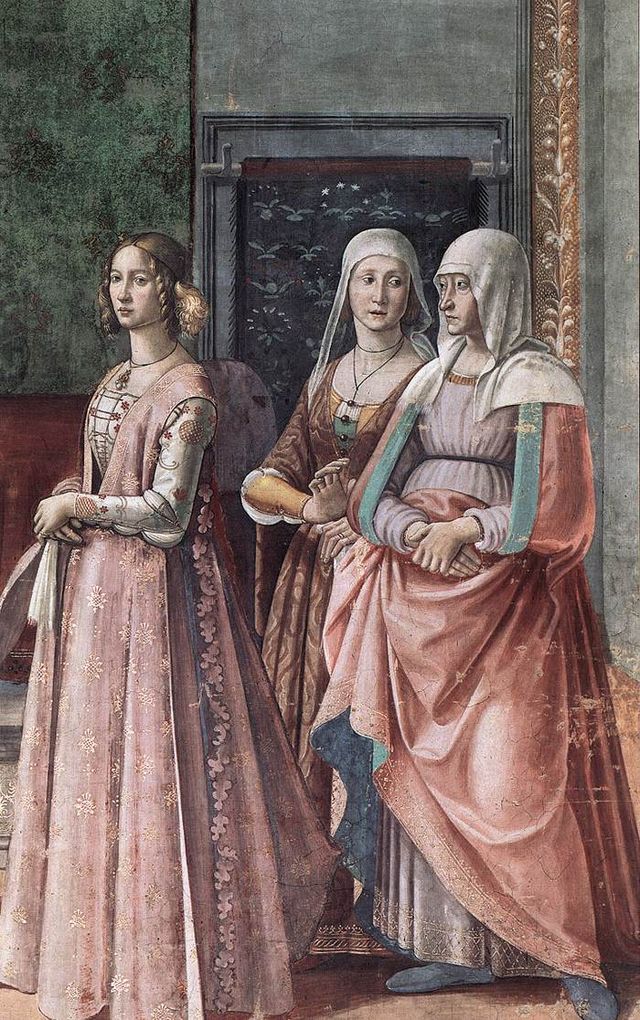
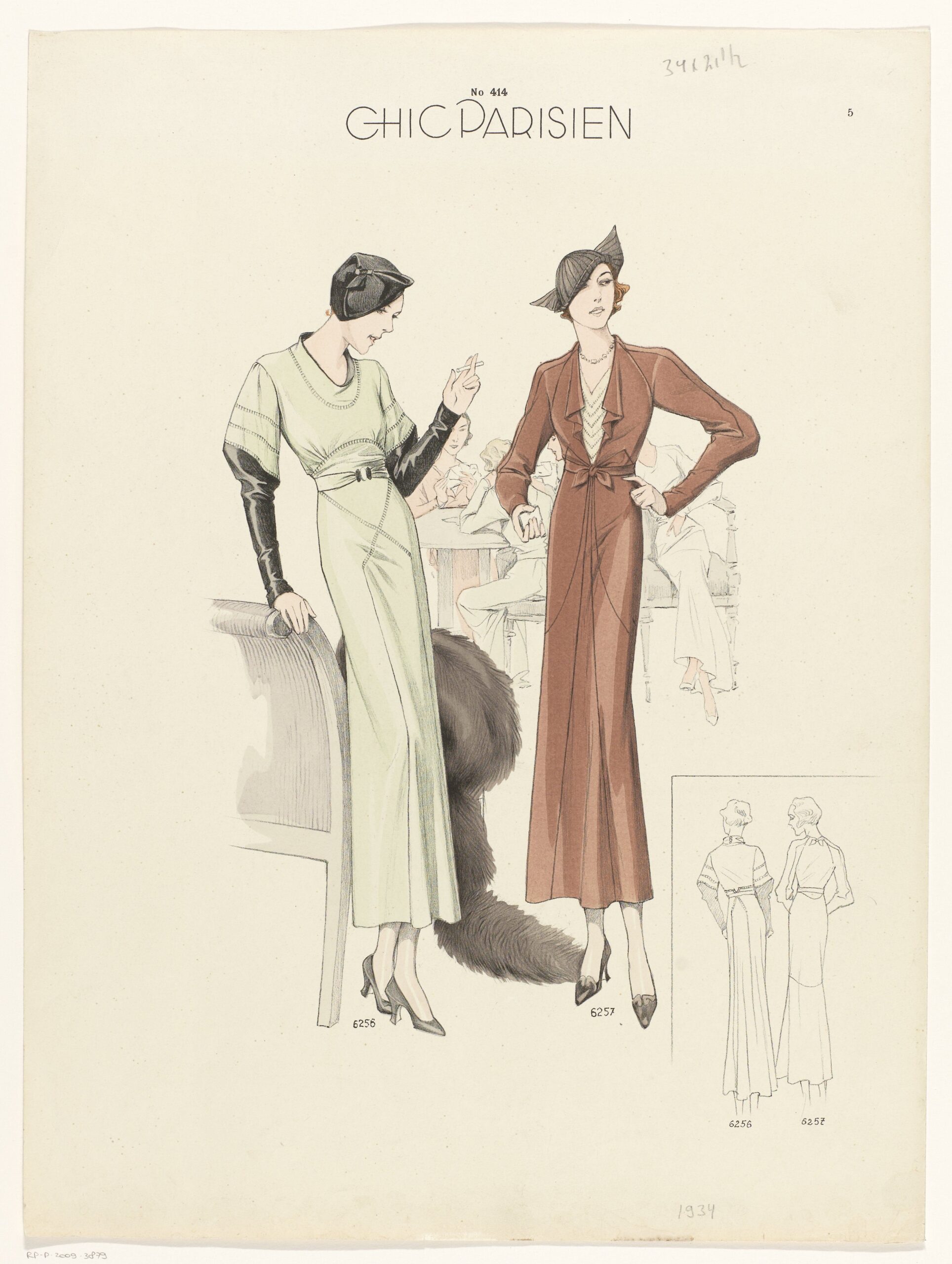
Of course, the dresses of the fashion plate achieve artistic success, and relative to anything available on the market today, they are excellent. Nevertheless, when compared to the gowns on the left, they pale.
Next, consider Filippo Lippi’s Madonna and Child:

Although Our Lady is portrayed here in the fashionable dress of the Italian Renaissance, there exists no discord between the spiritual theme of the painting and her clothing. The beauty of the clothing, rather than drawing the mind to the banal, lifts the mind to Heaven, thus giving wings to the painting’s theme. But if one were to see a painting depicting Our Lady in the clothing of the 1930s fashion plate, one would instinctively recoil. The elegance of fashion which we may admire and choose for ourselves, we see immediately is far inferior to the beauty always due Our Lady.
Catholic Culture Restoration
But if beauty is superior to mere elegance, why then, when I present the art principles, do I illustrate them with examples that are only elegant? The answer to this question is simply that I choose to promote fashion that stands some chance of resumption in our present day. This is not at all because I see the elegant as the apex of cultural restoration; actually, it is only a stop-gap measure, a concession which allows us some relief from ugliness while we wait for better days. The alarming truth is that culture, which in the words of von Hildebrand has been, “strangled by civilization,”[8] has reached such a state of decay, and art has reached such a state of perversion, that the world no longer has a place for beautiful clothing. It has lost the “poetry of life”[9] in which all the beauty of practical life (and clothes are a primary part of this) can be at home. Hildebrand writes:
The depoeticizing of the space we inhabit, which is profoundly linked to industrialization, goes hand in hand with a lack of interest in adequate external expression, and with a loss of the meaning and value of the ‘forming’ of our life. This is the victory of comfort and usefulness over beauty.[10]
Certainly, a clever seamstress might choose her preferred historical period and make for herself any number of beautiful articles according to the fashions therein, but in wearing them, she would find that because the world has cut itself off from beauty, she has cut herself off from the world. The “adequate external expression,” namely, that of beauty, which she wishes to convey to the world around her, meets its dull ears like the words of a foreign language. It cannot understand.
Dress, in fact, is a language. Julian Kwasniewski states:
Like language, and as a language of sorts, clothing is a mark of belonging in a communicative society. Clothing is an aspect of our being social animals; we are not, in fact, like the brute animals who do not create, discover, and communicate meaning through custom and culture.[11]
All throughout history, one sees a veritable lexicon of clothing customs: the cloth of gold reserved for royalty,[12] the head-coverings of married women of any class, and the plethora of geographically-linked ornamentation in the European folk tradition, only to name a few.
As soon as a person dresses, he conveys a message and asserts some meaning; he cannot fail to do so. If we argue that the ranks of our contemporaries who dress perpetually according to the athleisure imperative have no particular message to communicate, we are wrong; their clothing proclaims their message with perfect eloquence; namely, that all is meaningless. In a blur of digitally anesthetized despair, they drift through lives of bleak boredom captured in the popular song lyric:
“Nothing’s wrong when nothing’s true. I live in a hologram with you.”[13]
How can we respond? If even the proverbial “clever seamstress” cannot, by the sheer force of her skill resuscitate beautiful dress, then what hope have we who find ourselves at the mercy of the mass market?
I once attended a lecture on the theory of entropy, that is the world’s tendency to devolve into ever greater disorder. The professor of physics showed a video of a wine glass falling to the floor and shattering. He stated, “This is entropy.” Then he showed the video rewound. Shards of glass jumped off the floor and fused back together into the original flawless vessel. The professor flatly stated, “This never happens.” So, we see with dress; how easy to shatter; how difficult to restore.
And yet, all this notwithstanding, the fact that we will not, in our day, see a return to the fashions of the Italian Renaissance (or any other beautiful mode of dress), does not preclude the possibility, or rather the responsibility, to use whatever is left of the language of dress in its highest possible form. Our efforts may be pathetic, like the slurred and halting words of a stroke-survivor attempting his first rounds of speech therapy, but still, we must press on. To do anything else is to concede to the anti-culture of despair.
A religious sister once encouraged me, “It’s not difficult to form a sub-culture. You just get a small group of people who don’t care about being different and you all start being different together.” Communities of tradition-loving Catholics often provide inroads to the restoration of dress. They bring together like-minded people to celebrate solemn festal occasions in which a latitude of expression in dress rarely seen elsewhere is not only possible, but the norm. Such communities function as incubators in which people may come and try new ideas (which are really old ideas) together. The two classic examples being that the men wear suits and the women wear hats or veils to Mass. Of course, outside of Mass in the community’s various paraliturgical and social activities, still more opportunities for creativity abound.
If readers conclude that an admonition to “just try your best,” is a paltry solution to a dire problem, they are correct. But the hard truth remains that a return to more beautiful dress will take gigantic societal shifts that no person today has the power to enact. One such shift is a return to beautiful architecture. We will never feel completely at ease in beautiful clothing until the buildings we inhabit are once again beautiful. Another such shift is a restoration of hierarchical structures in society that allow for a differentiation between the various states and stations in the Christian life. Not everyone needs to dress in the silks of the nobility, but at least some should, and those who don’t ought to have some other dignified attire clearly born of their environment, their work, and their local customs. At present, our globalized and egalitarian society has neither the beauty of an aristocracy nor the charm of a folk tradition. C.S. Lewis puts it well:
This is, indeed, part of the general problem of a classless society, which is too seldom mentioned. Will its ethos be a synthesis of what was best in all the classes, or a mere ‘pool’ with the sediment of all and the virtues of none?[14]
Does not the state of dress today clearly demonstrate that we have indeed “the virtues of none”? And so, unable to transform abysmal architecture and failed social systems, we realize that we each can only do small things and hope for better days. It does bear noting that because standards have fallen to such lows, even a return to elegance will be a remarkable step forward for the cause of cultural restoration. And yet, all the while that we strive for elegance, we must remember how inferior this earth-bound aesthetic value is to beauty, the queen of all aesthetic values. We must persistently fight complacency and false contentment.
Espousing this attitude of artistic discontent, we will surely draw accusations of snobbery and tone-deafness. How can one recommend fragile linen dresses priced at two or three hundred dollars, when Amazon has indestructible polyester frocks for twenty? For that matter, how dare one quibble about the fine points of dress at all when many a devout mother struggles to feed and educate her eight children? But such questions spring from faulty logic. Difficulty feeding the children is a problem. And ugly dress is a problem. We must accept that both problems exist rather than dismissing the importance of the latter as long as the former prevails.
There is a common belief among some readers that in order to describe a problem with the current state of things, a writer must necessarily present a full-scale solution. (In this case, the solution would have to involve solving world hunger and the expenses of education). If he does not, then he had better not write at all. But of course, such a view is totally unrealistic and also debilitating to true restoration. Problems of the magnitude that we face today cannot be presented like clever little puzzles by a writer to his audience, for him to unravel before them revealing a neat solution at the end of his 1000 words. All that writers like myself can do is to present the problem clearly, describe how the problem was treated in the past, hazard one or two suggestions, and trust that the same spirit which guides us to write in the first place may also guide our readers to take up their parts of the restoration with creativity, prudence, and holy zeal.
All photos not in the public domain are courtesy of Cameron McCarty and property of Anna Kalinowska (Copyright 2024).
[1] Dietrich von Hildebrand, Aesthetics Volume I (Steubenville, Ohio: Hildebrand Project, 2016), 81.
[2] Ibid, 77.
[3] Ibid, 399-400.
[4] Linda Przybyszewski, The Lost Art of Dress (New York: Basic Books, 2014), 30.
[5] “Cage Crinoline,” Fashion History Timeline, https://fashionhistory.fitnyc.edu/cage-crinoline/
[6] “The Fall of the Weavers,” Monkey Town: The History of Heywood, https://www.heywoodhistory.com/2016/06/fall-of-weavers.html
[7] “The Parasol 1777,” Costume Cocktail, https://www.costumecocktail.com/2016/12/04/the-parasol-1777/
[8] Dietrich von Hildebrand, Aesthetics Volume II (Steubenville, Ohio: Hildebrand Project, 2016), 52.
[9] Hildebrand, Aesthetics Volume I, 4.
[10] Hildebrand, Aesthetics Volume II, 400.
[11] Julian Kwasniewski, “Do We Dress for Beauty?” Tradition and Sanity, https://traditionsanity.substack.com/p/do-we-dress-for-beauty.
[12] Daniel Roche, The Culture of Clothing (New York, New York: Cambridge University Press, 1996), 39 – 49.
[13] Lorde. “Buzzcut Season.” Track 6 on Pure Heroine. Republic Records, 2013, YouTube.
[14] C.S. Lewis, “The Necessity of Chivalry,” Present Concerns, ed. Walter Hopper (New York, New York: Harper Collins 1986), 6.


